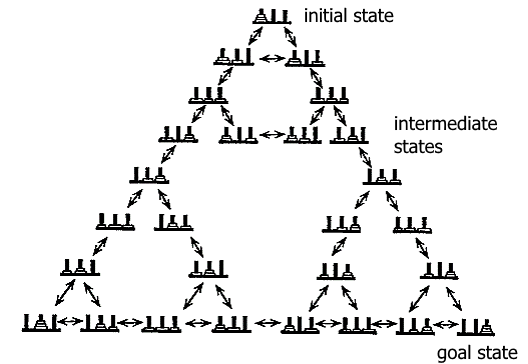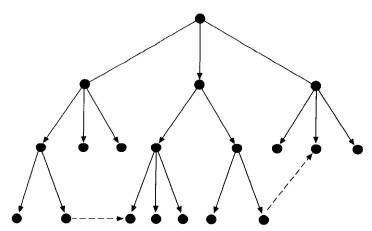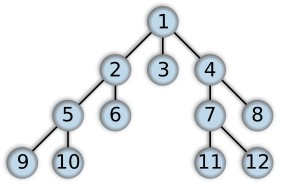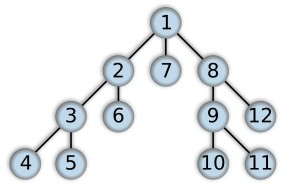
1. What are three forms of problems?
2. What are the requirements for understanding a problem?
3. Describe Newell & Simon’s theory on problem solving.
4. How much do analogies contribute to problem solving?
5. What are the effects of mindlessness, mental set, functional fixedness, past experience, incubation, and insight?
6. What are the four views on insight?
7. Describe the differences between experts and novices in terms of encoding, representation, and problem solving.
8. How is expertise (and skill) acquired?
9. What is creativity and how can it be measured?
10. What factors affect creativity?
• ____-defined: initial state, goal state, and permissible operations completely specified
e.g., (3x-2)(2x+5)=(3x-2)(x+4), solve for x
• ___-defined: uncertainty in one or more components
e.g., write a _____
Forms of problems (Greeno, 1978):
• Problems of Inducing _________: determine relationship among several given elements
e.g., analogy problems (Miller Analogies Test)
- four steps required to solve:
1. encoding: identify appropriate attributes
2. _________: relate 1st and 2nd elements
3. _______: relate 1st and 3rd elements
4. application: relate 3rd and 4th elements
• Problems of ______________: find sequence of operations to transform initial state into goal state
e.g., Tower of Hanoi (Édouard Lucas, 1883)
- skill required: means-end analysis?
• Problems of ___________: arrange elements according to a criterion
e.g., ________: arrange the letters AIFMA to make a word
- skills required:
▸ generate possibilities/reject impossibles
▸ constrain search
▸ retrieve solution patterns
Three requirements for understanding a problem (Greeno, 1991):
1. _________: representation comprised of parts connected in a way that makes sense
2. ______________: internal representation “maps well” onto elements of the problem
3. relationship to __________ knowledge: problem elements linked to existing knowledge
• _________: set of operations that systematically and exhaustively generates a solution
e.g., What’s the mean of 3, 4, 2, 5, 3, and 7?
• _________: strategy that often helps generate a solution; do not guarantee success
e.g., When do you take another card in blackjack?
Newell & Simon (1972): Human Problem Solving
• _______ _____: collection of nodes, each representing a state of knowledge or possible action
- problem solving seen as search through problem space
• states:
- initial
- intermediate
- goal

• _________: links between nodes; consist of functions selected to solve problems
- there may be path constraints ruling out some possibilities
General Problem Solver (Newell, Shaw, & Simon, 1959):
- computer program intended to simulate human problem solving
- applied _____-___ analysis:
• transform: compare current state and goal state; note any differences
• reduce: find operator that most reduces the difference
• apply: apply operator to current state
- subgoals create intermediate states that are closer to the goal state
- pros & cons:
![]() successfully applied to Tower of Hanoi, logic proofs
successfully applied to Tower of Hanoi, logic proofs
![]() requires ____-_______ goals/problem spaces to function
requires ____-_______ goals/problem spaces to function
![]() poor simulation of human problem solving:
poor simulation of human problem solving:
• people inadvertently move backward, make illegal moves
e.g., Hobbits & Orcs Problem
• does not draw on stored _________
• short-term memory limits the number of subgoals (3 steps?)
- solving a problem by using a solution to a related problem
- requires:
• seeing similarity in basic structure of the problems
• inferring appropriate solution for current problem from analogous problem
Duncker (1945): the radiation problem
- patient has inoperable stomach tumour
- can be destroyed by high _________
- will also destroy any healthy tissue it passes through
- low radiation is ineffective
- what to do?
Gick & Holyoak (1980):
- control group: given radiation problem
- analogy group: also given analogous fortress problem:
• goal: use army to capture fortress
• resources: sufficiently large army
• constraint: unable to move army along road all at once, due to mines triggered by large numbers of troops
• operators: divide army; move army; attack using army
• solution: send _____ groups along ________ roads ______________
- analogy + hint group: also given hint that second problem would help with the first
- results:
Group: |
Solved: |
control |
8% |
analogy |
30% |
analogy + hint |
92% |
- people can infer solutions from analogies--if they realize the analogy is appropriate (difficult to do)
- also important: time between 1st and 2nd problems:
Delay: |
Solved: |
none |
10% |
short |
32% |
long |
12% |
- abstraction: participants given ________ similar analogies were more likely to use analogy
Mindlessness: thoughtless application of old ways of thinking to new situations without completely considering whether they are suitable
• entrapment by __________: thinking of objects only in terms of the categories they fit into
• _________ behaviour: doing things without thinking about them
• acting from a single ___________: thinking of only one way to accomplish a goal
Ellen Langer (1989; Langer & Piper, 1987):
- participants shown three unfamiliar objects: dog’s rubber chew toy, polygraph pen, hair dryer attachment
- half the participants given unconditional description:
e.g., “This is a dog’s chew toy.”
- other half given ___________ description:
e.g., “This could be a dog’s chew toy.”
- experimenter pretended to need an eraser; asked participants for help
- results:
• 40% of participants in conditional group gave a _______ response (use chew toy as eraser)
• 0% of other group did
Mental Set (Gestaltists: Einstellung or “attitude”): predisposition to solve a problem in a certain way
Luchins (1942): water jars problem
Jar A |
Jar B |
Jar C |
Want |
Answer |
29 |
3 |
- |
20 |
____ |
21 |
127 |
3 |
100 |
______ |
20 |
59 |
4 |
31 |
______ |
23 |
49 |
3 |
20 |
______ |
Functional Fixedness: inability to use objects for other than their most common purpose
Duncker (1945): candle problem
- participants were given candle, book of matches, box of tacks
- task: affix candle to the wall
- solution: ____ ___ to wall, use as candle holder
Causes of mindlessness:
• repetition of an action: becomes automatic
• premature cognitive commitments: maintaining a point of view even if it’s sub-optimal
• education: instruction in only one way of doing things, focus on outcome rather than learning itself
Past Experience: may help or hinder problem solving
Feather (1966):
- women asked to solve 15 anagram puzzles
- were given either easy or __________ anagrams
- estimated their chances before attempting each one
- last puzzle was moderate difficulty
- results:
Puzzle group: |
Estimate of success: |
Success on last puzzle: |
easy |
increased |
good |
impossible |
decreased |
poor |
- success may be a self-fulfilling prophesy
Incubation: problem solving facilitated by time away from it
Smith & Blankenship (1989):
- participants were given rebus puzzles and clues; some clues were misleading
▸ control gp: given 60 s per puzzle
▸ incubation gp: 30 s / interruption / 30 s
- prediction: incubation gp should benefit from interruption
- incubation gp performed ______; were also less likely to remember clues
• but: incubation effects not consistently found
• if found, may be due to:
▸ release (__________) from mental set/functional fixedness
▸ retrieval of new information by changing context
▸ recovery from _______
▸ conscious problem solving in the interim
▸ ___________ processes
- definition: a kind of problem solving characterized by:
• suddenness/surprisingness
• ease
• positive ______
• feeling of being correct/confidence
- the entire solution enters awareness at once (as opposed to a stepwise solution); a.k.a. the “Aha! ” moment
Wolfgang Köhler (1927): The Mentality of Apes
- stranded in Tenerife, Canary Islands during World War I
- observed Sultan, a caged chimpanzee in a scientific station
- Sultan used bamboo sticks as tools to reach ______ just outside of his cage
- also moved box underneath banana suspended from ceiling
- Rana, even after observing Sultan, was unable to do this
- Köhler’s book influenced writing of 2001: A Space Odyssey, and Planet of the Apes
Gestalt View:
- insight problems require perception of the problem as a whole
• ____________ thinking: based on existing associations involving what is already known
• __________ thinking: insights that go beyond the bounds of existing associations
- causes of insight:
• extended (unconscious) leaps in thinking
• accelerated mental processing
• short-circuiting of ______ reasoning processes
- but: no evidence for this; poor definition of insight
Nothing-Special View:
- “insight” does not exist
- “insight” problems solved _______ sudden mental restructuring
- and routine problems solved with sudden mental restructuring
Neo-Gestaltist View (Janet Metcalfe, 1986):
- insightful problem solving distinguished by:
• low ________ in predicting success on insight problems; high accuracy for routine problems
• for insight problems, successful problem solvers were pessimistic about their ability; unsuccessful people were optimistic
- participants rated closeness to solution on 10-point scale (“cold” to “warm” to “hot”) at 15 s intervals
• routine problems: warmth increased gradually
• insight problems: mostly ____--then problem solved
Three-Process View (Davidson & Sternberg, 1984):
- there are three kinds of insight, involving three different processes
1. selective-________ insights: involve distinguishing relevant from irrelevant information
e.g., taking notes during a lecture: what’s important?
2. selective-__________ insights: involve novel perception of how new information relates to old
e.g., creative use of analogies; learning new definitions
3. selective-___________ insights: involve combining selectively encoded and compared information in a novel way
e.g., writing a term paper; solving the candle problem
Schooler, Ohlsson & Brooks (1993):
- task: a series of insight and logic problems
- gp1: required to _________ strategies while solving problem
- gp2: did not
- results:
% Correct |
Type of Problem |
|
Group |
Insight |
Logic |
verbal |
55 |
63 |
control |
80 |
67 |
- verbal overshadowing effect: “______ system” processing interferes with insight problem solving ability
Norman, Brooks, & Allen (1989):
- compared medical ___________ & med students
- task 1: interpret/diagnose patient data; recall as much as possible (__________ memory)
- task 2: given patient data, try to remember as much as possible (___________ memory)
- experts over twice as good on task 1; no difference on task 2
- experts have domain-specific schemas that aid remembering
Eylon & Reif (1984):
- developed two versions of a physics chapter
- one had traditional historical organization; other was hierarchical, based on physics principles and developed by experts
- high-school students using hierarchical text had:
• 40% improvement in retention
• 25% better scores in problem solving
- better structure and ______________ resulted in better performance
- interrelationships of knowledge is important
e.g., specific categories subsumed under more general ones
- ____________ organization:

(dotted lines represent mental _________)
- experts are better able to extract underlying structure from problems and sort them into categories
- novices are poorer at differentiation (representation is _______), and tend to sort problems by surface details
• _________________: converting declarative knowledge into procedural knowledge
Sweller, Mawer, & Ward (1983):
- studied novices solving kinematics problems
- explicitly wrote formula first: v = at
- eventually just wrote the ______: v = 2 × 10 (formula implicit)
• ________ learning: specific rules learned for specific problems
Greeno (1974):
- four repetitions needed to solve Hobbits & Orcs perfectly
- experts don’t solve problems all over from _______
• _________ learning: problem solving organized in an optimal way for problems in that domain
Anderson (1983):
- studied computer programmers
- experts developed solutions _______ first: worked out sub-problems recursively before coding

- novices went _____ first: identified first problem and solved it (i.e., typed code) before moving on

Anderson (1988):
- novices use ____-method procedures:
• domain-___________ (can be applied to any domain)
• require substantial mental effort to perform
• virtually identical to means-end analysis
- experts use domain-________ procedures:
• combinations of specific problem-solving situations and a series of ________ actions leading to solutions
• relatively automatically triggered
• created by successful repetitions
K. Anders Ericsson (& Pool, 2016; Ericsson & Charness, 1994):
- studied expert performers in many different domains, like chess, medicine, music, and sports
- expertise is not due to innate talent, extended intense training, or intelligence
- but extended, sustained deliberate ________: four general principles underlying performance improvement:
• has well-defined, specific goals
• is focused
• requires immediate feedback
• requires ___________ oneself
- the specific amount varies, depending on the skill
e.g., S.F. practiced digit span for about 200 hours
e.g., virtuoso pianists: about 25,000 hours
e.g., chess masters and Olympic medallists: 10,000 hours
- oversimpified as “10,000 hours” of full-time practice (the “10-year-rule”) by journalist Malcolm Gladwell (2008)
But practice doesn’t always make perfect (Macnamara et al., 2014):
- meta-analysis of 157 studies of sports, music, education, games, and professions
- related time spent practicing to ability
- on average, practice time accounted for just 12% of the variation in performance
- practice had almost nothing to do with ability in ________ classes or professions such as computer programming
- practice had the biggest effect on games such as chess (it explained 26% of performance differences), but it varied greatly (to reach “master” status, one person needed 728 hours whereas another took 16,120 hours)
- however, most of these studies did not measure deliberate practice
- success likely due to other factors like natural talent, general intelligence and _______ memory
• definition: the ability to produce novel, ______ ideas
• __________ thinking: thinking that proceeds toward a single correct answer
e.g., uses for a brick: to create a bridge, to make a house (all involve using a brick for building)
• _________ thinking: generating ideas that are different from one another; moving outward from a problem in many different directions
e.g., uses for a brick: as a doorstop, to smash a window, to cast a shadow, as a topic of conversation (each idea differs from the other)
Wallas (1926): stages of creative thought:
1. ___________: gathering information about the problem; characterized by painstaking work, with little progress
2. __________: problem set aside; solution may continue to develop unconsciously
3. ____________: key insight/new idea emerges
4. verification: confirmation that new idea leads to a solution
- evidence is equivocal
• J.P. Guilford (1967): creativity is discovering new, unanticipated approaches to a problem (more = better)
_________ Production Test: make as many and as varied responses to test item as possible
“Many words begin with an L and end with an N. In one minute, list as many words as possible that have the form L_______N.”
- ____ correlation between individuals judged more creative by coworkers, and score on this test
• Mednick & Mednick (1967): creativity depends on finding new connections among ideas
______ Associates Test: link 3 words with a common word:
cookies sixteen heart ______
poke go molasses ______
surprise line birthday ______
- ____ correlation between graduate students judged creative by their advisors, and RAT
• __________ assessment: done by expert panel
e.g., artists judge creativity of kids’ drawings
Amabile (1983): motivation
- kids told: a) be as creative as possible; or b) their work would be evaluated, most creative wins
- creativity greater in group a), who were intrinsically motivated
- creativity lesser in group b) due to _________ motivation: external rewards and incentives
Roe (1953): intelligence
- creativity generally related to IQ scores (but only up to IQ of ~___)
Mihály Csíkszentmihályi (1996): context
• ______: existing knowledge in a particular area
e.g., physics, music
• _____: social context, including social & public institutions
e.g., collaborators, mentors, rivals
Investment theory (Sternberg & Lubart, 1995):
- “___ ___”: see hidden potential of ideas presumed by others to have little value
• person creatively develops potential of idea to be meaningful
- “____ ____”: value of contribution is recognized; move on
• person has influence by being a step ahead
- component factors:
• processes of intelligence: ability to redefine problems, and think insightfully
• expertise: background knowledge to draw upon
• imaginative ________ skills: recognize patterns/use new perspectives
• venturesome personality: persistent, willing to take risks
• _________ motivation: creativity greater when not for pay
• creative environment: encourages creativity
Gardner (2011a):
- studied biographies of creative individuals
- concluded ___ of the above are important